Reading with Algorithms
If you are a reader who uses any of the social media platforms where books are promoted, discussed, and displayed, you will have seen certain book cover images repeatedly, similar book genre content pop up, and multiple versions of the same type of post or video suggested to you. One way of describing this type of "reading with algorithms" experience is to note that it involves repetition and similarity. As readers, we are also accustomed to encountering the recurrence of textual features through our familiarity with fiction and non-fiction genres. How do these readerly encounters connect to algorithmic repetition? In this essay, we pursue this question through the critical lens of genre as social action theory. We shift the action from "reading with algorithms" to "reading with genres" in order to ask: How do readers' knowledge of genre practices inform their online reviewing practices, and can we account for algorithms within those practices? We are going to approach "reading with genres" in social action theory from the perspective of a group of young adult readers with whom we worked online in a private chat group on Instagram. Across eight weeks, these readers discussed various issues, including their favourite book genres and television shows, their attitudes to bestselling fiction, and their use of social media. They also engaged in various activities that we suggested to them, such as reviewing a work of bestselling fiction on a platform of their choice and sharing it within the group.
Below, we take up genre as social action theory (GoSA) as a way of thinking about genre. Developed by scholars in New Rhetoric Studies, GoSA offers a generative mode of analysis, or a heuristic, for readers' online communicative actions, especially in relation to their book reviewing practices on social media platforms. GoSA has descriptive power when we examine what this group of young adult readers do when they read online. For example, young adult readers' attitudes to and management of algorithms provide a starting point for thinking about what it means to them to "read with algorithms." However, these readers' in-group conversations and book reviewing practices demonstrate that their knowledge of the genres of reviewing and of booktalk suggest how they are making genres as well as reading with them. We suggest that if we use GoSA theory to analyze what readers do, and what they say about what they do, then we can understand why the reviews on a specific platform share so much in common in terms of language use and content. Not all types of repetition come from algorithms.
Agent, Agency, Problem: Algorithms and Book Culture Studies
Algorithms present a challenge to investigating contemporary book cultures online. We understand them as both active and as acting upon the actions of users, but we do not always know if we should attribute any agency to them. Scholarly efforts to make sense of algorithms have, however, begun to move away from regarding them only as a mysterious, powerful yet impenetrable "black box." For example, Ted Striphas's recent work examines the history and geography of mathematics as part of his analysis of algorithmic culture.1 Similarly, critics and historians of computer programming pull our attention back to the human actions, motivations, and biases that structure programming languages.2 Most relevant to our own work as researchers of readers and reading, Simone Murray3 and Edmund King4 have recently brought algorithms into their examinations of reader-generated reviews on Goodreads, and to the negotiation of literary value through the posting cultures, affordances and dynamics of Twitter, respectively. Murray conceptualizes algorithms as "secret agents," a metaphor that conjures up the image of Cold War spies moving covertly through the fields of cultural production. Both scholars consider the limits to what we can know about how algorithms are being employed by companies like Amazon since they fiercely protect their protocols and operations. As King suggests, attending to scholarship and methodologies from platform studies brings some of those operations into sharper relief. Simon Rowberry's study of Amazon's patent applications for the Kindle offers an effective means of interrogating some of these,5 while Claire Parnell draws our attention to another type of what has been called "grey literature," such as the Terms and Conditions for publishing platforms like Wattpad.6 Even with limited knowledge, however, we can identify some of the economic effects of algorithms. We agree with Murray that we should not ignore the capitalist imperative that makes Bookstagram, Goodreads, and BookTok into nodes within a network through which money flows.7 Influencers working on those platforms, Amazon, and big publishing companies are among the parties directly profiting from this configuration of networked capitalism, after all.
A significant part of Murray's discussion relevant to our focus on "reading with genres," is concerned with how, by developing "statistical stereotypes," "algorithms [...] create normative models of readerly consumption."8 We can discern these models in readers' Goodreads reviews via the repetition of content and the expression of sentiment.9 Another indicator of those normative models that the reader can see is the quantity of reviews that accrue to the bestselling titles on that site. King reminds us that readers' practices online are always "entangled" with technologies that produce both "repulsive" and "affiliative" actions between users, but that it may not occur to users that algorithms affect what they see.10 For example, Parnell demystifies and details processes of sorting and cataloging that determine which books are "discoverable" to readers.11 Many of the results that user's searches on platforms like Wattpad generate reproduce another type of normativity that is problematic: whiteness, or, more precisely, the upholding of white power through sorting systems that foreground fiction that reproduces white power not only at the level of intratextual issues of representation but also in terms of authorship.
In sum, we know now more than we did about how patterns recur as a result of computational systems owned by some economically powerful agents. Sometimes, scholars directly attribute agency to the algorithms that "create" and "weave" secretly and with powerful, and often undesirable, ideological effects. As critics of media production and reception, we — as scholars working on contemporary book cultures — are understandably perturbed. But perhaps we can re-conceptualize the relationship between readers and algorithms differently, by thinking about it through the perspectives and actions of young adult readers who have been engaging with Web 2.0 for most of their lives?
Welcome to the Post-Digital Generation
Before we examine how GoSA enables us to make sense of readers' reviews and readers' relationships with "their" algorithms, let us introduce the readers group and the contexts within which they became a temporary online reading community. There were 16 avid readers in the group, ranging in age from 19-26 years old, which places them in the generation dubbed "Generation Z" by demographers and cultural commentators. Our readers were also in the uppermost age range for "Young Adult," a category that is currently used by book publishing companies and other media industries to denote a target market for whom specific products are manufactured and promoted, but which was historically constructed (at least in the North American and British contexts) by educators and librarians at least as early as the 1950s.12 Useful shorthand for researchers of reading, descriptive categories like "Gen Z" and "YA" are also generative for creative industry managers as they make sense of consumer data, some of which will have been gathered through data surveillance of readers' online activities.
The readers in our group had some awareness of these commercially driven data harvesting practices and the organizations that were profiting from them. They understood themselves as a digital generation associated with cross-media practices of consumption, and as a target group for transmedia products such as TV shows and films adapted by streaming services like Netflix from books. But they were also readers who preferred codex books to ebooks, who used physical as well as virtual libraries, and who valued a book recommendation offered by friends.13 In terms of their reading habits and media consumption practices, then, the group were immersed in "post-digital" culture: the era of digitization "wherein digital and analogue book technologies exist with simultaneous relevance."14
The extended discussion the readers had inside a private Instagram group took place asynchronously during May-June 2021. We had recruited the group as the final phase of a research project titled Reading Bestsellers: Recommendation Culture and the Multimodal Reader.15 We invited participants who identified as readers and who had an Instagram account to join an international group who would discuss books, review bestsellers, and undertake some other tasks. The 16 readers who joined were familiar with the affordances, features, and functions of the platform and had spent periods of time studying remotely in both synchronous and asynchronous online modalities during 2020-2021. As we explain below, their familiarity with online communication and learning informed their behaviour in the Instagram group. Alongside questions and conversations about their reading practices, media choices, and use of social media, we invited the group to undertake several creative and critically reflexive activities. These included imagining a book challenge that they would enjoy asking other readers to do, sharing an example from a social media platform that exemplified the type of post that inspired them to find out more about a book, selecting and then reviewing a work of bestselling fiction (in English) on a platform of their choice, and sharing the link and/or reposting the review in the group chat.
The relationship of the young adult readers to "their" algorithms is suggested in Figure 1 by @chooks, who shared with the group how she had chosen the bestselling fiction book for the reviewing task.
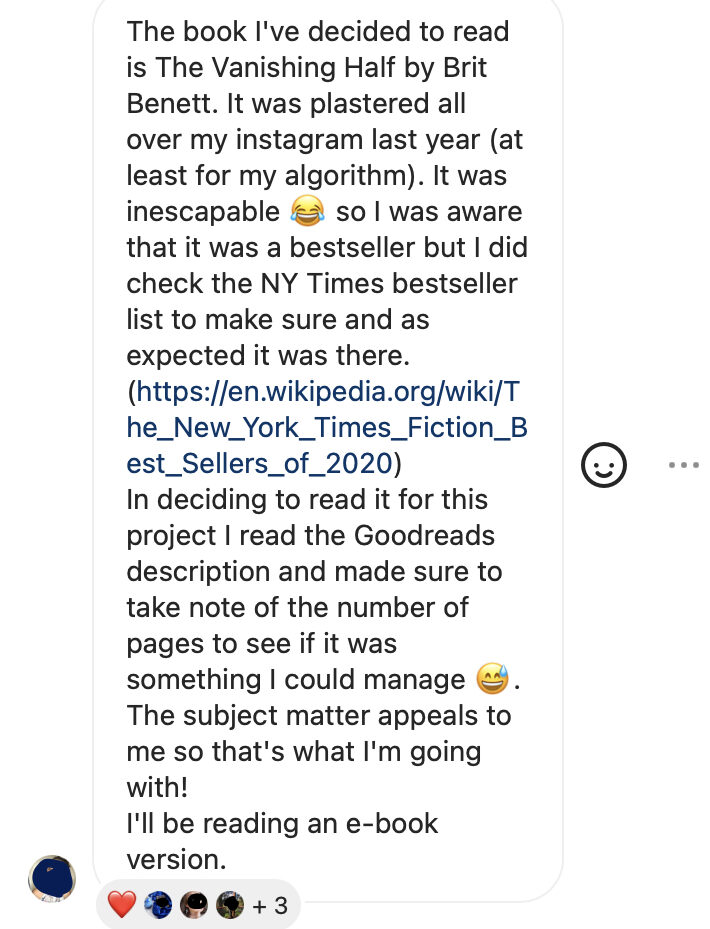
@chooks' remarks helpfully return us to our initial point about the repetition of content that algorithms generate, and the way that a reader often apprehends algorithms on their feed, grid, or via the thumbnails on YouTube. First, she identifies Instagram as one of the sources of information that she used for selecting a book to review. Second, she demonstrates her awareness that repetition and recurrence of images ("it was plastered all over," "inescapable," crying with laughter emoji) is a product of the algorithms on that platform. Third, @chooks recognizes that what she sees on her social media feed has been tailored to her, or rather, to "[her] algorithm." She indicates her understanding of the way that specific content is being shown on the basis of her previous likes, follows, comments, and the ways that her taste in books has been interpreted and re-presented to her by algorithms ("the subject matter appeals to me"). Other readers — including those in the group — may not have had the same experience of seeing this particular novel, Brit Bennett's The Vanishing Half (Penguin, 2020) because "their" algorithm might generate different patterns. So, @chooks qualifies her initial explanatory comment with "(at least for my algorithm)."
This statement stood out because it is one of only four explicit mentions of algorithms made within the group across two months of conversation. It reminds us that, from the perspective of these readers, algorithms are both a significant and a banal aspect of their engagement with post-digital culture and more specifically, with "networked reading"16 within reading recommendation culture. "Reading with algorithms" is therefore an inevitable practice for readers who use social media to find out about books, whether or not they choose to repost or reblog specific content, create an occasional review, or manage an account as a produser17 and would-be influencer, as one of our group members did. These different levels or intensities of involvement on and across platforms will have different impacts on a reader-user's online experience with algorithms. But @chooks' statement also foregrounded another type of reading act that our reviewing request called forth: "reading with genres." What we mean by this depends on a conceptualization of genre not as a textual form consisting of structures and conventions that are "recognizable and categorizable" in the way that genre is commonly understood within the academic discipline of literary studies,18 but upon the conceptualization of genre as more dynamic and active: as a "social typification."19
Exigence! Action! Genre!
The "genre" in GoSA generally refers to a rhetorical genre that can be spoken or written. GoSA theorists do not exclude aesthetic forms like novels, plays, and films from their consideration of genres, but they do mark them as "artistic genres" that are distinct from the institutional genres that initially preoccupied the scholars who elaborated GoSA. When access to the internet started to become more ubiquitous in the early 2000s, academics working in rhetoric studies identified and examined newly emergent online genres such as blogs.20 The study of emerging new media genres was particularly intriguing to these scholars because it was "communicative activity that [was] voluntary and relatively unregulated."21 These "vernacular genres" were created "by voluntary communities of use in internet environments" rather than those created in "more regulated environments such as corporations [and] schools."22 In that early phase of widespread online communication, it was apparent that users were drawing upon their knowledge of common genres such as diaries, as well as on communicative situations and actions that recur in common social situations. As Devitt explains, genre as an organizing principle is used every day as people go about their lives,23 and, as Giltrow says, genre provides "background knowledge" about any text, object, or event that forms a type of agreement between the producer or receiver of utterances that is mutual and unsaid.24 Our chat group readers participated in genres of social action that were primarily vernacular in character (using friendly chat forms like messaging), but that also drew on institutional practices like "doing research." Identifying genre is not about delineating taxonomies of types; it is more dynamic. It is, in fact, like those emergent new media genres suggested so powerfully, productive of knowledge because genre is a "form of social knowledge—a mutual construing of objects, events, interests and purposes that not only links them but makes them what they are."25 People make genre even as they recognize it, but genre only coalesces if there is evidence of socially recognizable recurrence and repetition.
We can explain GoSA theory more fully by applying its terms and concepts to the situation of and communicative activities within our research group. Even if they were no longer students, all the readers recognized (or construed) the event of our research as an "exigence"; that is, "an externalization of motive . . . [that] takes rhetorical action out of the realm of individual psychology and into the social arena."26 As Miller remarks, "without motive, no action; without exigence, no socially recognizable action."27 The Gen Z readers recognized that "talking" in the group, although often informal, was motivated by our research agenda. Notwithstanding the particular sense of "agenda" as ideologically informed and involving an imbalance of power in terms of who benefits the most when it is served, the readers apprehended the motive and took action. They began to communicate because they understood one of the exigences to be "make some data for the researchers to analyze." Human actions, specifically communicative acts, are interactive and prompted by communally understood cues.
Our readers were conversing together in English regardless of whether it was their first, second, or third language, but what other factors informed their ability to collectively recognize the multiple exigencies of an online private group chat? In one of her later essays, Miller points out that "a rhetorical exigence can be recognizable in more than one social sphere, and a given social sphere or community can sustain multiple exigences."28 The group members were experienced "rhetors" who were accustomed to using chat functions on various apps to connect with friends and family. They were also used to communicating about intellectual ideas and their learning within pedagogical situations through functions like Zoom chat or online forums in a virtual classroom. The sphere of online learning and the familial or friendship spheres accessed through SMS, WhatsApp, or direct messaging on Instagram of course require different types of language use. Our readers were sufficiently familiar with communicating within both spheres and so shared the conditions within which the exigences of research as a genre of social action could be recognized. But they also recognized the exigencies of vernacular booktalk because the conditions or structures within which these exigencies occur assist the mutual comprehension of these readers.
Medium is an important part of these conditions structuring how the readers communicated. In particular, medium informs how people make a genre of social action online because of how "the technicity of the medium'' operates within online communications to restrict or promote rhetorical repetition.29 The technicities of the Instagram chat medium required the readers to pay attention to chronology (they had to scroll up to get the full context of a conversational thread) and to answer or respond to a previous question or comment. Comments could be short or long; links were possible, as was the reposting of content from another platform; emojis could be used; photos could be uploaded. Recurring rhetorical forms that readers employed included: declarations of identification and recognition ("me too!"); the use of emojis to express humour, self-deprecation and stress; and, exchanging recommendations of books to read. This latter form of communication is not surprising given that the group members identified each other as readers. Sharing book recommendations was, in fact, a genre of social action that was already recognizable to and part of the social knowledge that the readers had in common. They enacted it early on within the group chat without any explicit prompting from us. Their action was prompted by the multiple conditions of the communicative situation, including the medium within which it occurred. They employed this particular genre of "booktalk" toward a social purpose; it became part of getting to know each other alongside sharing photos of pets and favourite places near where they lived. The readers' uptake of this genre of social action is a helpful reminder that while computational systems can recognize proximity and similarity, they cannot recognize social action. People — rhetors — make genres, and a genre of social action coalesces socially when it becomes recognizable within a community of use.
Reading with Genres: Reviewing Bestselling Fiction

Frau_lehrerin's comment in Figure 2 suggests a mixture of confidence in her genre knowledge of Goodreads reviews combined with a nervousness about sharing it more publicly outside of the private group chat. In common with several other group members, she had stopped creating social media posts about books on a regular basis, but when tasked with making a review for an online platform, she understood both the formal conventions of a Goodreads review and the function of it as a communicative genre. In fact, as researchers, what we learned from asking the group to review a work of bestselling fiction written in English was simply this: most of them were able to enact the genre of the online book review well. We had already questioned them about their social media habits and had explicitly asked them to share their selection processes for their book choice within the group chat. They were all aware of some of the conditions within which readers make genres of recommendation online. Since they were given a choice about which social media platform to use for their review, most of the group chose one that was familiar to them. Of the 13 readers who completed a review, Goodreads and Bookstagram were chosen by six and three readers respectively; two readers posted on Facebook with one of them cross-posting on Medium; one reader only posted within the private chat group; and one reader produced what she described as "a casual review" on YouTube. Even while they responded to the exigences of making the reviews for research purposes and for their temporary community, most of them made reviews that were a social typification — a genre — that communities of readers outside of the group on other platforms would both recognize and potentially find useful.
The readers who created reviews for posting on Goodreads, for example, demonstrated their knowledge of the Goodreads review genre by responding to its exigences, which include "explain to other readers why you would recommend this book or not." Five of the six Goodreads reviews were not very long because these readers know from their own experience that users will probably scan multiple reviews in an attempt to gain a sense of the book. Indeed, several of the readers reported using Goodreads in this way when they were selecting their bestseller. As @iona.george00 put it, "My first step was to jump onto Goodreads as that's where I get most of my book suggestions from." She chose Legend by Marie Lu (2011, Putnam Juvenile; the first book in a series), which was partly based on a recommendation from a friend. As @iona.george00 puts it in Figure 3, after giving the book four stars:
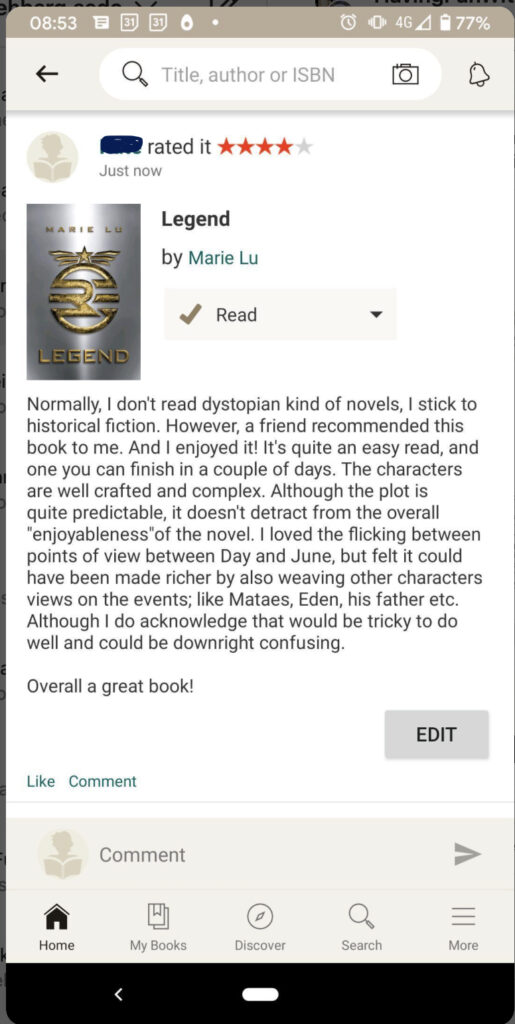
In addition to responding to the social cues and exigences outlined above, @iona.george00's comment that "it's quite an easy read, and one you can finish in a couple of days," is a recurring feature of the Goodreads reader review genre. It is both a response to an implicit rhetorical cue — "is it pleasurable?" — and an expression of value that is embedded within and sustained by this genre of social action — "is it worth my time?"
It takes a while for genres to coalesce as socially recognizable, and a marker of their successful uptake by rhetors is how effectively they communicate the information and values that a community of use requires.30 You do not have to have written a review before to understand the exigencies of the genre, or to comprehend the values the genre sustains, but you do need to have social knowledge about how and why they work gained through repeated encounters with them. This is why Momo was able to mimic the Bookstagram genre for her book choice even though she had never written a book review for an online platform before tackling this task. Her playful, conversational asides ["(okay I took a few breaks)"; "me likey"] are perhaps too informal for the public (and published) Bookstagram genre but they register the in-group genre of recommendation that had coalesced within the private chat. Like Frau_lehrerin quoted above, Momo announces the posting of her review to the group (Figure 4a), to signal a change of tone and purpose in her communication. Figure 4b is the version of her review posted inside the chat that includes the hashtag we asked the readers to use:
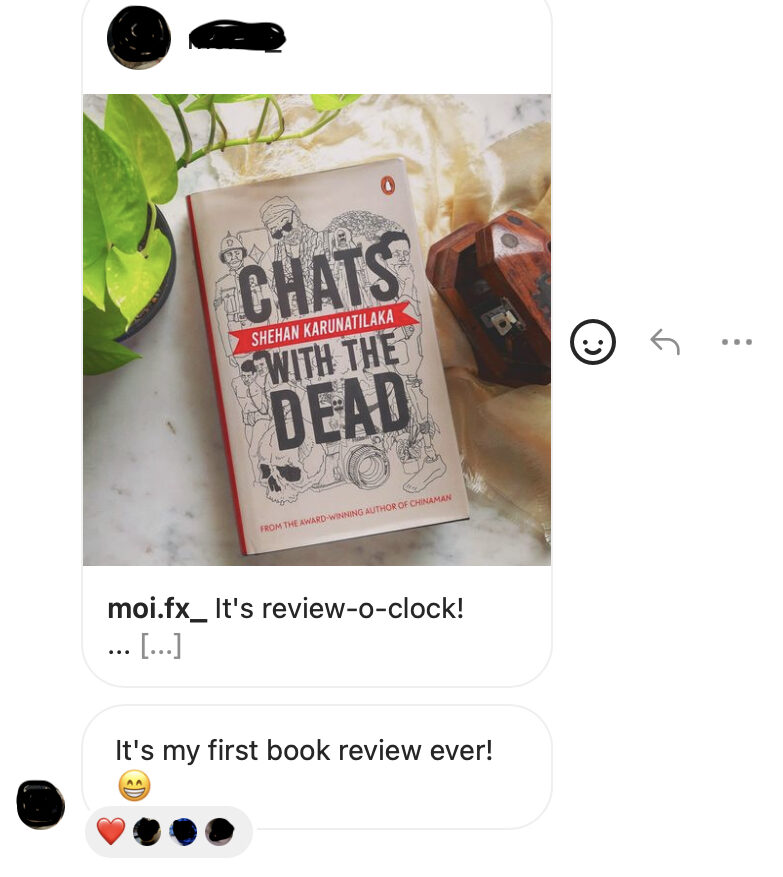
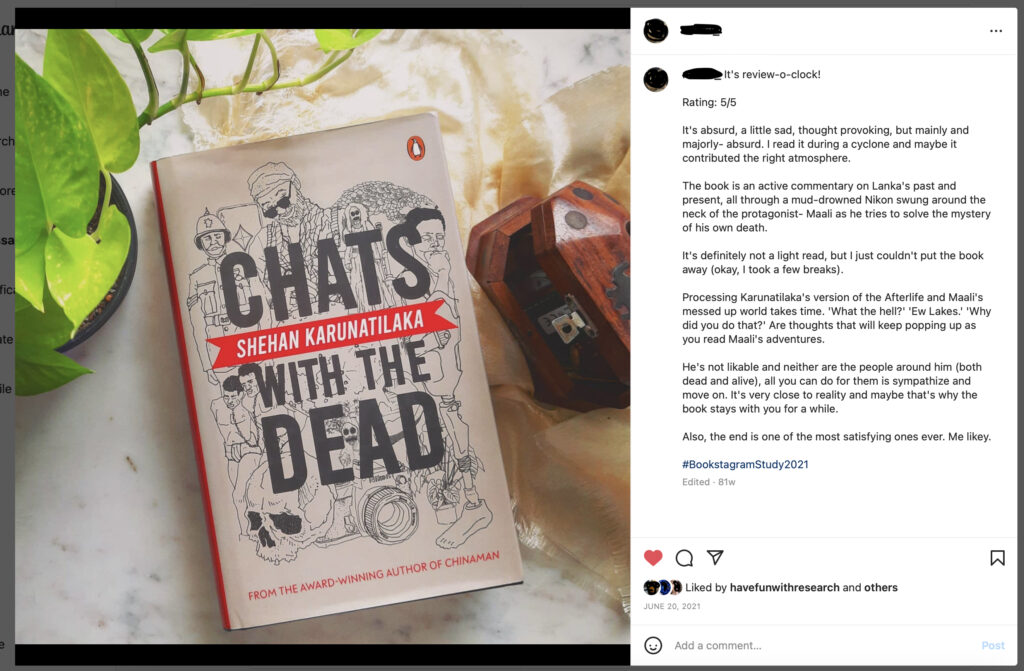
Despite this being her first book review within an online culture of reading recommendation, Momo manages to meet the social and rhetorical cues to comment on characterization and plot without giving too much away. She expresses something about how it felt to read the book, conveying a sense of its pacing and its success at holding her attention ("I just couldn't put the book away"). Her photograph (Figure 4a) demonstrates a knowledge of the visual repertoires that have become normalized on Bookstagram, with a simple but aesthetically effective flat lay of a few objects juxtaposed with her hardcover codex copy of the book. What she misses about the Bookstagram review genre is the use of multiple hashtags: she only includes the one for our study. Perhaps this reflects a nervousness about drawing public attention to her post from a wider group of readers outside the relative comfort of the group, since that's what the practice of employing multiple hashtags generally achieves.31 It is notable that two of the three readers who made Bookstagram posts for their reviews used linking/hailing features like hashtags and user handles very sparingly. Only the reader who regularly posted reviews on the platform met this particular rhetorical cue that is enabled by a technicity of medium. In her review of Detransition Baby by Torrey Peters (Penguin Random House, 2021), Bella used 21 hashtags (an amount that is typical for an influencer), including paratexts such as the author's name, publisher's name, the book title, temporal hashtags (e.g., #ReadWithPride; #PrideMonth); reader-oriented tags common to Bookstagram (e.g. #TBR, #Bibliophile), and tags that hailed her followers (#LondonFriends). Her post, reproduced in part below, Figure 5, without the 44 public comments and the hashtags, is a more sophisticated and practiced iteration of the genre than Momo's (see Figures 4a and 4b).
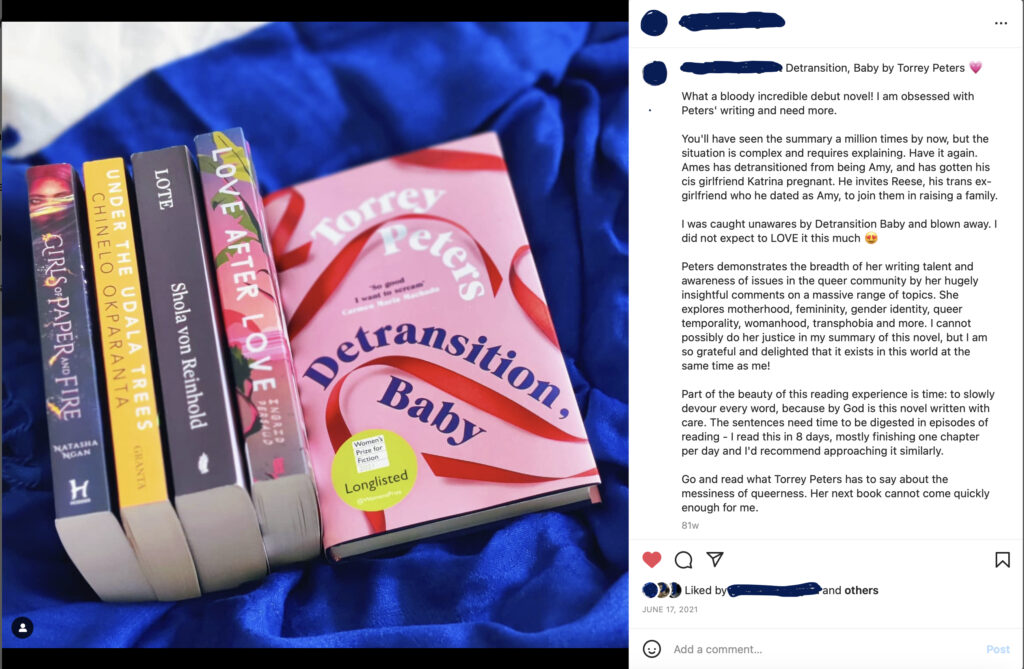
Bella's more expert-level of genre knowledge comes across in her opening and closing sentences that blend the language of advertising tag-lines and promotional book blurbs with the affective-evaluative discourse adopted by readers on most online platforms ("bloody incredible novel," "LOVE it," hearteyes emoji + "her next book cannot come quickly enough for me"). Notable too is the intensification of the genre-embedded community value around time: not only does she describe the novel as worthy of readers' time but, in fact, she explicitly suggests that a slow, considered pace is advisable in order to appreciate "the beauty of this reading experience." Part of her recommendation is not only for the book itself, but also for the type of reading experience that is possible if you follow her recommendation about how to read it. Like the text, Bella's photo is an elegant aspect of her successful genre iteration: she shows the front cover of the featured book and the spines of four others that she was reading during the same month (all of which were tagged in the post by their titles). She not only displays her taste in fiction genres but also a desire for literary cosmopolitanism because not all the books were originally published in English nor are they all by authors from the same region of the world.
What is not present here are the more overtly political reasons why Bella chose Peters' novel, particularly her knowledge of controversies around issues of representation on prize lists and her belief in practicing a type of ethical consumerism — all of which she shared in the Gen Z group when explaining her selection (Figure 6):
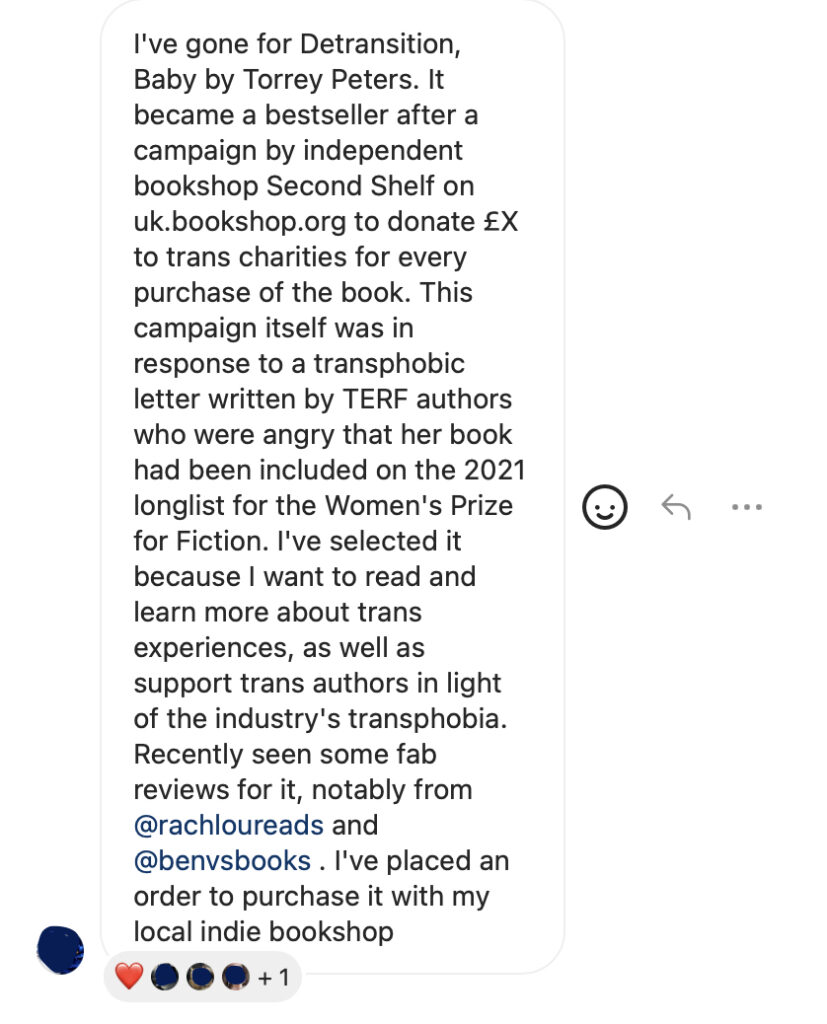
The fact that Bella omits these details from her review indicates, perhaps, the limitations of genre practices in online book reviewing, or, at least, the difficulty of elaborating these motivations for reading a particular book. It is thus not only algorithms that produce normative models of readerly consumption, as Murray suggests, but the way that genre recurs and is taken up within communities of use.
In common with our other group members, Bella's review is positive, which indicates the situation and conditions of the Instagram group itself. The young adult readers had invested energy and effort into their selections, and so the likelihood that they would find pleasure in their book choices was high. If there were aspects that they did not enjoy, they were noted: for example, reviewing The Family Tree by Sairish Hussain (Harper Collins UK, 2020) for Goodreads, @bookswitadybug concluded: "Overall, brilliant book except that I would have preferred no cliffhangers (unless there's a part II coming soon, which I will for sure read!)." Similarly, if a book included content that might be upsetting for another reader, this was flagged in the posted review. For example, in LPK's GoodReads review about Lonely Castle in the Mirror by Mizuki Tsujimura (Poplar Publishing, 2017) she included "TW: Anxiety, suicide, child abuse." Content warnings within readers' online reviewing genres are another example of a community value becoming embedded in and sustained by a genre of social action. But it is also pertinent to note that within the private realm of the group, the readers had been offering each other more informal guidance about content, bullying, mental health, and experiences of being part of linguistic-minority communities within the cities and countries where they lived. In this way, the group began to expand on an aspect of reviewing genres as part of their own genre of social action around in-group recommendation as a form of connection, care, and support.
Concluding Discussion: Putting Algorithms in their Place.
In presenting a brief commentary on these examples from the Gen Z Instagram group, we have indicated how responding to exigencies of a genre can transmit certain in-community readerly values about a book and/or a reading experience. But what about algorithms, which, as we noted above, were only explicitly mentioned four times within the two months of the group chat? We would suggest that algorithms can be conceptualized as a condition within which genres of social action, such as book reviewing, recur. They are significant to rhetors' capacity to make and share genres online, but they are part of the background, both in terms of their functionality (for example, recognizing similarity and producing repetition of content), and in the sense that algorithms are part of readers' everyday knowledge about how new media operate. Genres of book reviewing online coalesce because they have become a social typification recognizable to communities of users. People recognize exigences that prompt social action; machines do not. Readers will take up and participate in genres that are useful to them because they wish to learn and communicate about books and reading experiences in mutually comprehensible ways. The articulation of a pleasurable reading experience is part of social action because it has a rhetorical intention. Sometimes this is overt and declarative ("Go and read...") but sometimes it is more implicit.
Even if we understand algorithms as a condition for online genres of reviewing, we cannot avoid the reality that reader engagement with those genres also involves an algorithmic encounter. The young adult readers' actions of research and review were also entangled with the algorithms used on various platforms. Our readers' selection processes and their publicly posted reviews both contributed to the ongoing "bestselling" success of the books that they had chosen, if only in a minor way. However, the readers in our study did not only depend on the genres of online book reviewing when making their choices of a book for the review task. It is the case that the majority of the Gen Z readers posted their review on a platform. But it was not their only means of choosing a book to review, nor, as we have illustrated, was it the only sphere in which they were making genres of booktalk and reviewing. They were also participating in offline social practices of reading and informal communities: friends' recommendations were especially important to them.
Here, it is helpful to repeat the fact that, prior to our research study, several of our Gen Z readers had stopped using Goodreads and Bookstagram mostly because of time constraints. These readers return to the sources of recommendation that they have come to trust through trial and error, and they abandon others. One reader no longer consulted any social media sources as part of their reading practices. In the final week of the group, Anastasia noted that her recommendation practices might change again (Figure 7):

Readers' practices and habits can change and the conditions within which genres of reviewing recur can alter, especially within an online environment "of dizzying volatility."32 Algorithms contribute to that volatility; they also produce some, but not all, of the repetition that readers encounter within online reading recommendation cultures. Thinking about genres of reviewing with the help of the Gen Z group and GoSA theory puts algorithms in their place — for now.
Danielle Fuller (@DrDFuller) is a Full Professor in the Dept. of English & Film Studies and an Adjunct in Sociology at the University of Alberta, Canada on Treaty 6/Metis Nation Region 4. Her most recent long-form publication, co-authored with DeNel Rehberg Sedo, is Reading Bestsellers: Recommendation Culture and the Multimodal Reader (CUP, 2023).
From K'jipuktuk, known as Halifax, Nova Scotia, DeNel Rehberg Sedo (@Dr_Rehberg_Sedo) works as a full professor in the Department of Communication Studies at Mount Saint Vincent University. She is also an adjunct in the Women & Gender Studies program (MSVU & St. Mary's University) and the Interdisciplinary PhD program at Dalhousie University. Reading Bestsellers: Recommendation Culture and the Multimodal Reader (CUP, 2023) is her latest published work with Danielle Fuller.
References
- Ted Striphas, "Algorithmic Culture," European Journal of Cultural Studies 18, no. 4-5 (August 1, 2015): 395-412, https://doi.org/10.1177/1367549415577392. [⤒]
- Safiya Umoja Noble, Algorithms of Oppression: How Search Engines Reinforce Racism (New York: University Press, 2018); Ruha Benjamin, Race After Technology: Abolitionist Tools for the New Jim Code (Cambridge, UK ; Polity Press, 2019); Cathy O'Neil, Weapons of Math Destruction: How Big Data Increases Inequality and Threatens Democracy, First edition. (New York: Crown, 2016). [⤒]
- Simone Murray, "Secret Agents: Algorithmic Culture, Goodreads and Datafication of the Contemporary Book World," European Journal of Cultural Studies (December 5, 2019), https://doi.org/10.1177/1367549419886026. [⤒]
- Edmund G. C. King, "Unpacking the 'Red Flag' Bookshelf: Negotiating Literary Value on Twitter," English Studies 103, no. 5 (July 4, 2022): 706-31, https://doi.org/10.1080/0013838X.2022.2087037. [⤒]
- Simon Peter Rowberry, Four Shades of Gray, Platform Studies (Cambridge: The MIT Press, 2022), https://doi.org/10.7551/mitpress/11985.001.0001. [⤒]
- Claire Louise Parnell, "Platform Publishing in the Entertainment Ecosystem: Experiences of Marginalised Authors on Amazon and Wattpad" (Melbourne, University of Melbourne, 2022), https://trove.nla.gov.au/work/250480152. [⤒]
- Claire Parnell and Beth Driscoll, "Institutions, Platforms and the Production of Debut Success in Contemporary Book Culture," Media International Australia (August 2, 2021), https://doi.org/10.1177/1329878X211036192. [⤒]
- Murray, "Secret Agents," 981. [⤒]
- Beth Driscoll and DeNel Rehberg Sedo, "Faraway, So Close: Seeing the Intimacy in Goodreads Reviews," Qualitative Inquiry 25, no. 3 (September 26, 2018): 248-59, https://doi.org/10.1177/1077800418801375. [⤒]
- King, "Unpacking the 'Red Flag' Bookshelf," 710. [⤒]
- Parnell, "Platform Publishing in the Entertainment Ecosystem." [⤒]
- Melanie Ramdarshan Bold, Inclusive Young Adult Fiction: Authors of Colour in the United Kingdom (London: Palgrave Macmillan, 2019), 21-44. [⤒]
- Danielle Fuller and DeNel Rehberg Sedo, Reading Bestsellers: Recommendation Culture and the Multimodal Reader, Publishing and Book Culture (Cambridge, UK ; Cambridge University Press, 2023), 57-72. [⤒]
- Alexandra Dane and Millicent Weber, eds., Post-Digital Book Cultures: Australian Perspectives (Clayton, VIC: Monash University Publishing, 2021), 1. [⤒]
- Danielle Fuller and Rehberg Sedo, Reading Bestsellers. [⤒]
- Bronwen Thomas, Literature and Social Media, Literature and Contemporary Thought (London ; New York: Routledge, 2020). [⤒]
- Axel Bruns, "From Prosumer to Produser: Understanding User-Led Content Creation," in Transforming Audiences 2009, 2009, https://eprints.qut.edu.au/27370/. [⤒]
- Kim Wilkins, Beth Driscoll, and Lisa Fletcher, Genre Worlds: Popular Fiction and Twenty-First-Century Book Culture, Page and Screen (University of Massachusetts Press, 2022), 6. [⤒]
- Carolyn R Miller, "Where Do Genres Come From?" in Emerging Genres in New Media Environments, ed. Carolyn R Miller and Ashley R Kelly (Springer International Publishing, 2017), 25. [⤒]
- Janet Giltrow and Dieter Stein, "Genres in the Internet: Innovation, Evolution and Genre Theory," in Genres in the Internet: Issues in the Theory of Genre, ed. Janet Giltrow and Dieter Stein (John Benjamins Publishing Co, 2009), 1-25. [⤒]
- Miller, "Where Do Genres," 22. [⤒]
- Miller, "Where Do Genres," 24. [⤒]
- Amy J. Devitt, "Re-Fusing Form in Genre Study," in Genres in the Internet, 27-47. [⤒]
- Janet Giltrow, "Genre and the Concept of Pragmatic Background Knowledge," in Genre and the New Rhetoric, ed. Aviva Freedman and Peter Medway (Taylor and Francis, 1994), 155. [⤒]
- Carolyn R Miller, "Genre as Social Action," in Genre and the New Rhetoric, 30. [⤒]
- Carolyn R. Miller, "Exercising Genres: A Rejoinder to Anne Freadman," Discourse and Writing/Rédactologie 30 (August 20, 2020): 134, https://doi.org/10.31468/cjsdwr.843. [⤒]
- Miller, "Exercising Genres," 134. [⤒]
- Miller, "Exercising Genres," 138. [⤒]
- Carolyn R. Miller and Dawn Shepherd, "Questions for Genre Theory from the Blogosphere," in Genres in the Internet: Issues In the Theory of Genre (John Benjamins Publishing Co, 2009), 284. [⤒]
- Miller, "Where Do Genres," 23. [⤒]
- Kenna MacTavish, "The Emerging Power of the Bookstagrammer: Reading #bookstagram as a Post-Digital Site of Book Culture," in Post-Digital Book Cultures: Australian Perspectives, ed. Alexandra Dane and Millicent Weber (Melbourne: Monash University Publishing, 2021), 80-112; Bronwen Thomas, "The #bookstagram: Distributed Reading in the Social Media Age," Language Sciences 84 (2021), https://doi.org/10.1016/j.langsci.2021.101358. [⤒]
- Miller and Shepherd, "Questions for Genre Theory," 264. [⤒]
